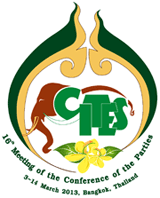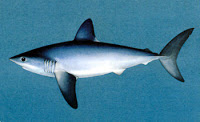

| Visitors Now: | |
| Total Visits: | |
| Total Stories: |

| Story Views | |
| Now: | |
| Last Hour: | |
| Last 24 Hours: | |
| Total: | |
CITES: important meeting for conservation, but what’s it all about?
Within the conservation community, a lot of attention has been placed lately on the upcoming March meeting of CITES (Convention on International Trade in Endangered Species of Wild Fauna and Flora). Specifically, CITES will hold it’s sixteenth Conference of the Parties meeting (CoP16) on March 3-14 in Bangkok, Thailand. The significance of this event is that this is where the member nations, of which there are 177, will meet to review the status of a wide range of animal and plant life to determine whether their status within the organization should be changed.
What catches the most attention from conservationists is the CITES Appendix listings (I, II & III) which determines what regulations or measures the member nations must abide by regarding a particular species. Here is a breakdown of the three categories as outlined in the CITES website:
“Appendix I lists species that are the most endangered among CITES-listed animals and plants. They are threatened with extinction and CITES prohibits international trade in specimens of these species except when the purpose of the import is not commercial, for instance for scientific research. In these exceptional cases, trade may take place provided it is authorized by the granting of both an import permit and an export permit (or re-export certificate). The Convention does provide for a number of exemptions to this general prohibition.
Appendix II lists species that are not necessarily now threatened with extinction but that may become so unless trade is closely controlled. It also includes so-called ‘look-alike species’, i.e. species of which the specimens in trade look like those of species listed for conservation reasons. International trade in specimens of Appendix-II species may be authorized by the granting of an export permit or re-export certificate. No import permit is necessary for these species under CITES (although a permit is needed in some countries that have taken stricter measures than CITES requires). Permits or certificates should only be granted if the relevant authorities are satisfied that certain conditions are met, above all that trade will not be detrimental to the survival of the species in the wild.
Appendix III is a list of species included at the request of a Party that already regulates trade in the species and that needs the cooperation of other countries to prevent unsustainable or illegal exploitation. International trade in specimens of species listed in this Appendix is allowed only on presentation of the appropriate permits or certificates.”
In the proposed agenda for CoP16, there is a long list of species being proposed to either be added to one of the appendices, changed from one appendix to another, or removed altogether, based on a determination of endangerment status. There is a request from the United States to have the polar bear given Appendix I status and there are other refinements to the existing status of animals such as the white rhino and African elephant.
For shark and ray conservationists, CITES always offers the opportunity to get international cooperation in limiting or prohibiting trade in particular shark species. For this upcoming meeting, the oceanic whitetip shark , three species of hammerhead shark, the porbeagle shark and the manta ray are all up for consideration in the Appendix II category. All of these have been the target of commercial fishing for fins – or, in the case of the manta ray, for its gill rakers – and there has been a concerted effort by advocacy groups to make their positions known to CITES members through petition drives and their own planned presence at the March proceedings.
The challenge faced by conservationists with an organization like CITES is that it represents a wide range of interests. Its very name makes reference to ongoing, albeit regulated, trade in endangered species and this opens the door for political and economic interests to have a say right along with those of a strictly biodiversity nature. Case in point: at the last Conference of the Parties in 2010, many shark advocates were disappointed with the results when several shark species, such as the porbeagle, were dismissed for Appendix consideration due to what was described as lobbying and back room negotiations from nations with strong commercial shark fishing interests.
However, CITES exists as one of the more prominent means to garner international support for the protection of plants and animals. With regards to sharks, while nations may declare safeguards and prohibitions within their own territorial waters, these animals do not know to confine their movements within those safe zones. Long range migratory patterns put these animals at risk as they enter international waters. Therefore, the international arena of diplomacy and closed door politics figures into the strategy of conservation groups worldwide, even though it can be a difficult and frustration strategy to successfully execute.
While international cooperation is noteworthy and necessary, illegal trade activities pose a serious threat to many endangered species. In fact, it can become a vicious cycle, for as a species becomes more endangered, its value in the illegal or black market increases which serves as an inducement for further exploitation.
At CoP16, there will be a meeting of the ICCWC (International Consortium for Combating Wildlife Crime). The ICCWC will be discussing new proposals, including the need for a global system of enforcement. Manpower and funding resources have always been a key issue regarding enforcement, but it is an issue that CITES wishes to address.
“Illegal trade in wildlife is escalating, is transnational, and is increasingly well-organized. Our collective response needs to be commensurate with the nature of the risk at both the political and operational levels,” said John Scanlon, Secretary-General of CITES.
The conservation community will be watching CITES’ CoP16 proceedings closely. You can follow along and learn more at the CITES website or by staying in touch with your favorite conservation organization involved in international activities.
Source: CITES.org
2013-02-24 16:01:32
Source: http://rtseablog.blogspot.com/2013/02/cites-important-meeting-for.html
Source:





